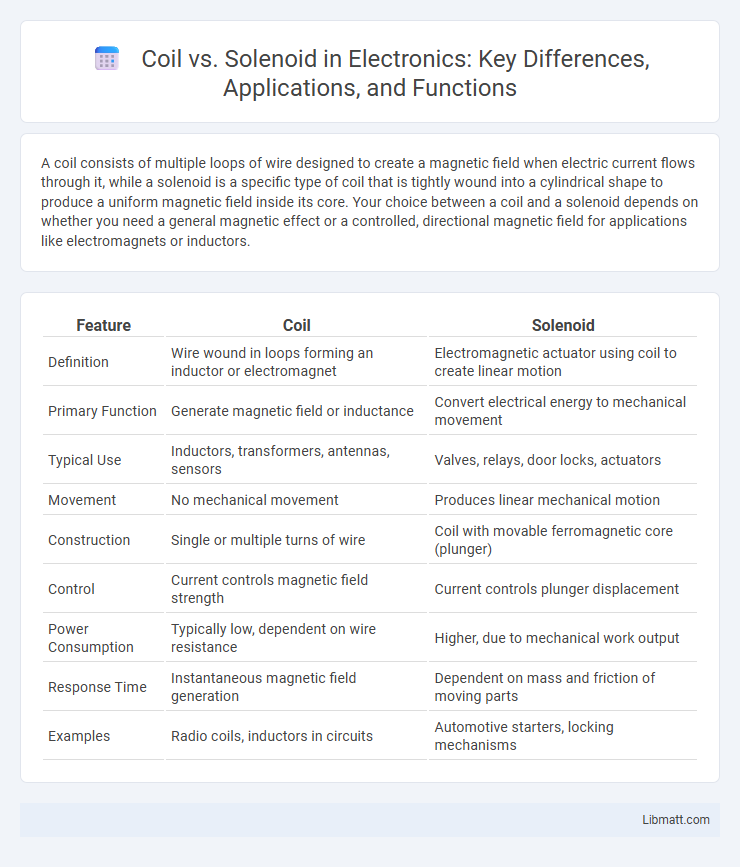A coil consists of multiple loops of wire designed to create a magnetic field when electric current flows through it, while a solenoid is a specific type of coil that is tightly wound into a cylindrical shape to produce a uniform magnetic field inside its core. Your choice between a coil and a solenoid depends on whether you need a general magnetic effect or a controlled, directional magnetic field for applications like electromagnets or inductors.
Table of Comparison
| Feature | Coil | Solenoid |
|---|---|---|
| Definition | Wire wound in loops forming an inductor or electromagnet | Electromagnetic actuator using coil to create linear motion |
| Primary Function | Generate magnetic field or inductance | Convert electrical energy to mechanical movement |
| Typical Use | Inductors, transformers, antennas, sensors | Valves, relays, door locks, actuators |
| Movement | No mechanical movement | Produces linear mechanical motion |
| Construction | Single or multiple turns of wire | Coil with movable ferromagnetic core (plunger) |
| Control | Current controls magnetic field strength | Current controls plunger displacement |
| Power Consumption | Typically low, dependent on wire resistance | Higher, due to mechanical work output |
| Response Time | Instantaneous magnetic field generation | Dependent on mass and friction of moving parts |
| Examples | Radio coils, inductors in circuits | Automotive starters, locking mechanisms |
Introduction to Coils and Solenoids
Coils and solenoids are fundamental electromagnetic devices used to generate magnetic fields through electric current. A coil is a wire wound into a helical shape to enhance inductance, commonly utilized in inductors and transformers. Solenoids consist of coils designed specifically to produce a controlled magnetic field and linear motion, making them essential components in electromechanical systems such as valves and actuators.
Basic Definitions: What is a Coil? What is a Solenoid?
A coil is a simple loop or series of loops of wire designed to create a magnetic field when electric current passes through it. A solenoid is a specific type of coil, typically cylindrical, that generates a uniform magnetic field in its interior when energized, often used as an electromagnet or actuator. Understanding the distinction between a coil and a solenoid helps you choose the right component for electromagnetic applications.
Key Differences between Coils and Solenoids
Coils are simply loops of wire designed to create a magnetic field when electric current flows through them, often used as inductors or electromagnets. Solenoids consist of a coil wrapped around a metallic core and function as electromechanical devices that convert electrical energy into linear motion. Understanding your application requirements is essential since coils primarily generate magnetic fields, while solenoids provide controlled mechanical actuation.
Working Principles of Coils
Coils operate on the principle of electromagnetic induction, where an electric current passing through a wire winding generates a magnetic field around it. The strength of the magnetic field depends on factors such as the number of turns in the coil, the current magnitude, and the core material used. This magnetic field can induce voltage in nearby conductors or create mechanical force, making coils essential components in transformers, inductors, and electromagnets.
Operating Mechanism of Solenoids
Solenoids operate by converting electrical energy into linear mechanical motion through the interaction of a magnetic field generated by a coil and a movable ferromagnetic plunger. When energized, the coil produces a magnetic field that pulls the plunger towards the center of the coil, creating controlled movement used in various actuators and switches. This operating mechanism allows solenoids to provide precise, rapid, and repeatable actuation essential in automotive starters, locking systems, and industrial automation.
Common Applications of Coils
Coils are widely used in transformers, inductors, and electromagnets due to their ability to generate magnetic fields when electric current passes through them. In wireless charging devices and electric motors, coils facilitate energy transfer and motion control by converting electrical energy into magnetic energy. They also play a crucial role in sensors and inductive components, enhancing signal processing and electromagnetic interference suppression in electronic circuits.
Solenoid Applications in Modern Technology
Solenoids are widely used in modern technology for precise control in automotive starters, industrial automation, and medical devices like MRI machines. Their ability to convert electrical energy into mechanical movement makes them essential in actuators, valves, and locking mechanisms. Your devices rely on solenoids for efficient, reliable operation in various sectors, from consumer electronics to heavy machinery.
Design Considerations: Coil vs Solenoid
Design considerations for coils prioritize flexibility in shape and size, enabling custom inductance values and efficient heat dissipation for electronic applications. Solenoids require precise mechanical design to convert electrical energy into linear motion, focusing on core material, winding density, and magnetic field strength to optimize actuation force. Coil designs favor electromagnetic properties for signal and power applications, whereas solenoids prioritize structural robustness and mechanical movement efficiency.
Advantages and Disadvantages
A coil provides uniform magnetic fields and is ideal for applications requiring precise control, while its disadvantage lies in limited force generation compared to solenoids. Solenoids deliver strong linear motion and high force output, making them suitable for mechanical actuation but can consume more power and generate heat. Understanding these trade-offs helps you select the appropriate electromagnetic component for your specific application needs.
Choosing Between Coil and Solenoid: Which Suits Your Needs?
Choosing between a coil and a solenoid depends on your specific application requirements, such as force, motion type, and control precision. Solenoids provide linear motion and are ideal for actuators in locking or valve systems, while coils primarily generate magnetic fields used in inductors or transformers. Assessing the desired mechanical output and electrical characteristics ensures you select the component that best suits your needs.
Coil vs Solenoid Infographic

 libmatt.com
libmatt.com